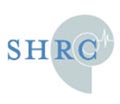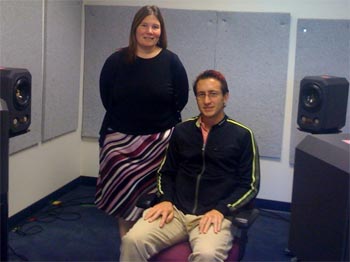Interview with Brent Edwards, Ph.D., Vice President of Research, Starkey
Topic: The Next Big Thing in Hearing Aid Technology
 CAROLYN SMAKA: Today I'm visiting the Starkey Hearing Research Center (www.starkeyresearch.com) in Berkeley, CA, and speaking with Dr. Brent Edwards. Brent, Welcome to AudiologyOnline.
CAROLYN SMAKA: Today I'm visiting the Starkey Hearing Research Center (www.starkeyresearch.com) in Berkeley, CA, and speaking with Dr. Brent Edwards. Brent, Welcome to AudiologyOnline.BRENT EDWARDS: Thanks, Carolyn.
SMAKA: Can you begin by giving us an overview of the research department at Starkey?
EDWARDS: Sure. We have significant efforts in research here in Berkeley and also in Minnesota. The center here in Berkeley opened four years ago, and was created to initially focus on basic auditory perceptual science questions. At Starkey, we feel that in order to achieve the next advances in technology that benefit those with hearing loss, we need to go back to a basic understanding of more complex aspects of auditory perception. Over the past several years with digital technology, we've captured a lot of the low-hanging fruit in terms of benefit, for example, with directional technology, noise reduction, etc. But to really understand the potential of new technologies, for example, ear-to-ear wireless technology, or to explore other areas of benefit for the hearing impaired, we need to better understand the complexities of auditory perception.
Initially when we opened this center, the first research projects underway were focused on binaural perception. We wanted to understand why we have two ears and look at more complex phenomena than things like head shadow. For example, how are the midbrain and the brain taking the signal from two ears and interpreting the world around us in order to facilitate communication, and how does hearing loss affect that ability? How do hearing aids affect that ability? We need to understand all of this at a basic level so we can then develop technology that will improve the lives of those with hearing loss.
Hearing and cognition was our other main area of research when we first opened. Hearing had really been considered mainly from the perspective of what's happening at the ear and in the cochlea. However, very complex analysis of the sounds that we hear is actually happening in the brain. The brain is parsing energy into different auditory objects and allowing one to focus on the source that one wants to hear in a complex environment. We know that people with hearing loss have difficulty in complex environments, so it seemed to us that hearing loss might be affecting cognitive function in some way. So we initiated a couple of projects, one of which is in collaboration with the psychology department at UC Berkeley and had as a goal in order to measure listening effort. We wanted to determine if hearing aids actually reduce the amount of effort necessary to understand speech in a noisy situation. I think audiologists intuitively understand this, because they know that people with hearing loss are typically more mentally fatigued after listening in a crowded restaurant for an hour, for example, than people with normal hearing. So, while we may intuitively understand that cognitive function is stressed more for people with hearing loss, no one had ever formally and scientifically demonstrated and measured it. And so we did just that, and we demonstrated that directional technology and noise reduction reduced the amount of effort for understanding speech in noise. And we are very excited about those findings, which will be published by the Journal of Speech, Language and Hearing Research.
So, at the Berkeley center, we're asking some basic scientific questions, with the understanding that, depending on the answers we get, it will lead to the development of new technology to help the hearing impaired.
Then we have more straightforward applied research where we're asking important research questions that are broadly applicable but are targeting a specific issue. In our case, these questions are focused on potential areas of benefit for those with hearing loss. An example of this type of applied research is a project that we have on frequency translation. We've spent a lot of effort to really understand the impact of a frequency translation algorithm on speech acquisition, consonant confusions, vowel identification, learning, and a variety of other areas.
And then we have the closest level of research that leads to a product and that's what I call technology development. With this type of research, you have technology that exists and you're trying to apply it in new ways. An example might be investigating a noise reduction algorithm that exists in cell phones and its applicability to hearing aids in order to benefit people with hearing loss. Another example might be investigation of the application of nanotechnology that exists in other industries, to see if it can be used to make hearing aids more water resistant. So this type of research is much closer to the development of a final product, but it still looks at unknowns or open questions that need to be answered.
So, at Starkey, we have a variety of levels of investigation underway and they're all required in order to really make progress. Each level requires a different timeframe but overall we're thinking in the long term. And our efforts and teams in Berkeley and Minnesota are set up accordingly.
SMAKA: From an outsider's perspective, when you hear of research being done by a hearing aid manufacturer, you tend to think it's all 'direct to product' type of research. But what you're describing is a much broader scope of research.
EDWARDS: That's right. We're really thinking about the future - about what's going to happen five years from now. For example, we've known for a while that wireless technology is going to be seen in all hearing aids, but I don't think our industry has a great understanding of the full benefit that wireless technology can provide to someone with hearing loss yet. The data to support cognitive benefit of wireless ear-to-ear, for example, has so far not been published. So we've got several initiatives underway to understand the potential benefits of wireless technology so that we have a lot of data, and an evidence-based development approach to support wireless technology when we introduce it.
SMAKA: You've mentioned quite a few instances of collaboration with other areas of science and with other industries.
EDWARDS: That's exactly right and that's quite a good observation. A philosophy that we've taken at Starkey is a fairly new concept in the field of innovation called open innovation. There's a business professor named Henry Chesbrough, who was at Harvard and is now at UC Berkeley, who has promoted this concept quite heavily. Open innovation refers to the fact that knowledge today is widely distributed, and companies can't afford to develop everything themselves anymore. A lot of companies have a "not invented here" approach to their work, meaning that if their own R & D didn't invent it, then it's not worth anything. To me, that's somewhat of a naïve opinion. The world is so complex today. In our field, you have to have an understanding of audiology, engineering, psychology, and physiology, in order to really develop the next breakthroughs. We rely a lot on our internal resources, but we also rely a lot on outside experts and other industries. So, that's why we're here in Berkeley, so we can collaborate with world-leading experts on the UC Berkeley campus, and we're also close to Silicon Valley, so we can collaborate with some world-leading technology companies. And, we also collaborate with universities across the U.S. and Europe.

The Starkey Hearing Research Center is
located in the Power Bar building in
downtown Berkeley, CA
SMAKA: Our industry is so small, I would imagine that if we had to rely only on what we developed within our own industry, we'd never get to the next big thing in hearing aids, whatever that is.
EDWARDS: You're exactly right about that. So, one of the tasks that we've taken on is to identify leaders in various areas of research that we think can collaborate with in order to help us better understand hearing loss. That would then eventually lead to the development of technology to benefit people with hearing loss. And once we've identified those leaders, we will visit their universities, or have them visit our research center, and we'll get them excited about hearing loss and hearing aids.
SMAKA: How do you bring someone from outside the industry and get them excited about hearing loss?
EDWARDS: Well, you have to be able to speak their language. The challenge is first getting their respect as a research colleague and then helping them identify areas of opportunity for their research with regard to hearing loss. You have to have their respect as a scientist in order for them to trust what you're saying. That's why it's important that the people we have in Starkey research have a high level of expertise and produce a high quality of research. That will get us in the door, so to speak, and then the job is easy. The reason it's easy is because most researchers at a university don't have the opportunity for their work to benefit millions of people, the way it can when their work is applied to hearing loss. The result of most university researchers' work is the publication of their research, adding to the scientific knowledge and thinking in their field that is then read by their colleagues. The ability for their research to more directly improve the lives of millions of people with hearing loss around the world is an opportunity that excites every single person I've talked to about it. It's easy to convince them that ours is a great field for applying their work.
One example of such a collaboration is with the cognitive scientists here at UC Berkeley. When we first opened the center here, they knew nothing about hearing loss or hearing aids, but we worked with him to identify how their research could be applied to this field. That's why today we have a paper in publication demonstrating the benefit of hearing aids to cognitive function.
SMAKA: Excellent. You mentioned a high caliber team of researchers. Tell me about your team here.
EDWARDS: For our researchers, we want to get the best available worldwide. It's also important for us to hire researchers with a diversity of expertise. I don't think if I sat in a conference room full of people who all thought like I did, that the opportunity for new ideas would be that great. But if I sit in a room with people all having with different expertise, that's really where the new ideas come from. You get really exciting ideas for new approaches when you learn about how things exist in one field and how they relate to our field. It's also important that we get people who are great at communicating and who have a certain level of creativity. I think both are important for collaborating and for innovating these new ideas.
Our research teams in Berkeley and Minnesota collaborate quite a bit. We've got some sophisticated technology set up so we can work together and we also travel back and forth. We pass protocols back and forth as well. So we might run a few subjects here in Berkeley, and Minnesota might have different expertise that can improve the experiment or a much bigger patient database to draw upon, so they'll take that same protocol and continue the investigation. Or, they may start an experiment in Minnesota based on some ideas that they have, and then a researcher in Berkeley might want to continue it by testing something else, so we'll just electronically pass the data over. We've got the equipment and technology set up such that we can easily do that.
SMAKA: Not everyone is an audiologist on your team. Most people probably aren't, is that correct?
EDWARDS: Correct. Again, we've got a variety. We've got signal processors, hearing scientists, someone with a neurophysiology background, and someone from cochlear implants. It's important to have these collaborative teams to bring forth new ideas. When you team up someone who is an expert in electroacoustics but knows little about hearing loss, with someone who's an expert in hearing loss, and maybe doesn't know a lot about acoustics, the opportunity for new ideas is amazing.

Starkey research audiologist Susie Valentine,
and research programmer Dan Steele
SMAKA: I would love to sit in on those meetings. It sounds exciting.
EDWARDS: They're a lot of fun.
SMAKA: Brent, you've touched on some of your areas of research, and some of the new ideas you've been investigating. What do you see as the next big thing in hearing aids - where is the technology going?
EDWARDS: Well, as digital technology continues to get smaller and faster, just like with personal computers, you'll see more and more features get added. We'll see algorithms improve and get more sophisticated, and the addition of new algorithms. But broadly speaking, I think the new next wave of real innovation and benefit for those with hearing loss is in wireless technology. There are applications and areas of benefit for ear-to-ear wireless and ear-to-remote device wireless that we can't even imagine right now that we're going to be developing over the next ten years. It's going to require the integration of engineering with basic science to make that happen. Because auditory perception is complex, as our technology gets more complicated, it's important that we understand the best way to integrate technology with auditory processing.
We're also still starting to understand the complexities of binaural perception and how hearing loss and hearing aids affect that. One of the biggest international conferences in hearing loss research is the ISAAR Symposium in Denmark. In fact, I just received an invitation today to speak there next year and the theme of the conference will be binaural perception. This conference picks themes for each meeting that are emerging topics of high research interest and with the potential for high impact to the hearing loss world. The last one, where I was also an invited speaker, was on cognition and complex auditory functioning. These are indications that these topics are going to produce the next wave of technology. But it's going to be a challenge because we've captured a lot of the low-hanging fruit in terms of what hearing aids can do. There's a lot of opportunity for further advancements, but it's going to take some real smart people applying rigorous evidence-based approach to the technology. And I don't mean producing technology that sounds cool but may or may not have benefit. That's what happens sometimes if you just leave things up to engineers, and I'm an engineer so I can say that (laughs).
To really develop technology that benefits people, you've got to have a team of bright people from a variety of fields, and you have to prove that the technology really does provide benefit. And you have to ensure that it provides benefit not just in the clinic, a very artificial situation, but in the real world.
SMAKA: You've referred to benefit throughout our interview today.
EDWARDS: Maybe 'benefit' is a mantra for me because quite often it is easy to forget. You get caught up in cool technology and you have to remember, ultimately, that it's about improving the lives of the hearing impaired. You need to keep that in mind right at the beginning and it's very important for us, as we consider basic science. There's a whole world of interesting scientific questions that can be asked about hearing loss. But there's a much smaller subset of those questions that will produce solutions to help those with hearing loss. So, we need to make sure we're asking the right research questions when we investigate and develop our research projects. If you're project isn't going to lead down to a path to improve benefit, then quite frankly, Starkey isn't going to do that. We can leave that to other researchers. At Starkey, we're focused on benefit in everything we do. As Starkey's President Jerry Ruzicka always talks about, our work is focused on improving the patient journey.
SMAKA: Brent, thanks so much for having me here today and for making time for this interview.
EDWARDS: It's been a pleasure.

Starkey Online Courses
Starkey offers online courses for professionals on the latest products, software, marketing and business solutions, as well as a variety of clinical topics, including:
S Series: Evidence Based Design
The Lifestyle Experience: Creating a System that Maximizes the Patient Journey
Market More Successfully to Prospective Patients
All courses are free to view and many are CE-eligible as part of AudiologyOnline CEU Total Access. Visit the Starkey Web Channel on AudiologyOnline for a current listing of all courses.
About the Starkey Hearing Research Center
The SHRC is a division of Starkey Laboratories, the world's largest manufacturer of custom hearing solutions. The research conducted at the Center is focused on two primary tracks: auditory perceptual science and signal processing technology. Basic psychoacoustic and speech research assists in developing new signal processing algorithms, new diagnostic-based fitting procedures, and new patient-benefit validation approaches. Signal processing research enhances the functionality of digital hearing instruments and improves both sound quality and speech understanding for the hearing impaired. For more information about the Starkey Hearing Reseach Center, visit www.starkeyresearch.com/
About Starkey
Starkey Laboratories, Inc. is a privately held, global hearing technology company headquartered in Eden Prairie, Minn. The company is recognized for its innovative design, development and distribution of comprehensive digital hearing systems. Founded in 1967, Starkey currently employs over 3,500 people, operates 18 international facilities and conducts business in over 100 markets worldwide. The Starkey Laboratories family of companies operates a number of divisions including Audibel, Micro-Tech, NU-Ear and Starkey. For more information about Starkey, visit www.starkeypro.com

